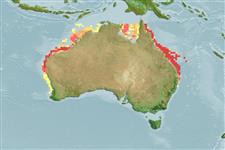>
Scombriformes (Mackerels) >
Scombridae (Mackerels, tunas, bonitos) > Scombrinae
Etymology: Grammatorcynus: Greek, gramma = signal, mark + Greek, rhyngchos = snout.
More on authors: Quoy & Gaimard.
Environment: milieu / climate zone / depth range / distribution range
Ecologia
marinhas associadas(os) a recifes; oceanódromo (Ref. 51243); intervalo de profundidade 15 - 50 m (Ref. 86942). Subtropical; 12°S - 37°S, 110°E - 157°E (Ref. 168)
Western Pacific: known only from the northern coasts of Australia, south to Shark Bay in western Australia, along the east coast of Queensland south to northern New South Wales. Recently reported from the Gulf of Papua (Ref. 9684) and Ouvéa Atoll, Loyalty Islands (Ref. 13236).
Tamanho / Peso / Idade
Maturity: Lm ? range ? - ? cm
Max length : 112 cm FL macho/indeterminado; (Ref. 40637); peso máx. publicado: 13.5 kg (Ref. 168)
Espinhos dorsais (total): 11 - 13; Raios dorsais (total): 10-12; Espinhos anais 0; Raios anais : 11 - 13; Vértebras: 31. Mouth relatively small, upper jaw reaching about to middle of eye. Pectoral fins stout. Interpelvic process short and single. No prominent anterior corselet present. Swim bladder present. Vertebrae 14 precaudal plus 17 caudal, total 31 as in the mackerels (Scomber and Rastrelliger).
Form schools near individual bays and reefs in Barrier Reef waters. With the rising tide, they move into shallow water over the reef flats, feeding on schools of clupeoid fishes that concentrate there. Utilized as a food fish.
Ciclo de vida ou comportamento de acasalamento
Maturidade | Reprodução | Desova | Ovos | Fecundidade | Larvas
Collette, B.B. and C.E. Nauen, 1983. FAO Species Catalogue. Vol. 2. Scombrids of the world. An annotated and illustrated catalogue of tunas, mackerels, bonitos and related species known to date. Rome: FAO. FAO Fish. Synop. 125(2):137 p. (Ref. 168)
Status na Lista Vermelha da UICN (Ref. 130435)
Ameaça para os humanos
Harmless
Uso pelos humanos
Pescarias: espécies comerciais; peixe esportivo: sim
Mais informação
Nomes comunsSinônimosMetabolismoPredadoresEcotoxicologiaReproduçãoMaturidadeDesovaAgregação de desovaFecundidadeOvosDesenvolvimento dos ovos
ReferênciasAquaculturaPerfil para aquaculturaEstirpesGenéticaElectrophoresesHereditariedadeDoençasProcessamentoNutrientsConversão de massa
ColaboradoresFotosStamps, Coins Misc.SonsCiguateraVelocidadeTipo de nataçãoÁrea branquialOtólitosCérebrosVisão
Ferramentas
Relatórios especiais
Baixar XML
Fontes da internet
Estimates based on models
Preferred temperature (Ref.
123201): 22.6 - 27.8, mean 26.1 °C (based on 108 cells).
Índice de diversidade filogenética (Ref.
82804): PD
50 = 0.7500 [Uniqueness, from 0.5 = low to 2.0 = high].
Bayesian length-weight: a=0.00955 (0.00464 - 0.01966), b=3.05 (2.88 - 3.22), in cm total length, based on LWR estimates for this (Sub)family-body shape (Ref.
93245).
Nível Trófico (Ref.
69278): 4.5 ±0.80 se; based on food items.
Resiliência (Ref.
120179): médio(a), tempo mínimo de duplicação da população 1,4 - 4,4 anos (Preliminary K or Fecundity.).
Fishing Vulnerability (Ref.
59153): High to very high vulnerability (75 of 100).
Nutrients (Ref.
124155): Calcium = 13.5 [7.3, 31.5] mg/100g; Iron = 0.667 [0.348, 1.307] mg/100g; Protein = 22.5 [21.0, 23.8] %; Omega3 = 0.207 [0.118, 0.377] g/100g; Selenium = 18.2 [8.9, 38.7] μg/100g; VitaminA = 47.3 [15.5, 157.7] μg/100g; Zinc = 0.447 [0.293, 0.689] mg/100g (wet weight);
